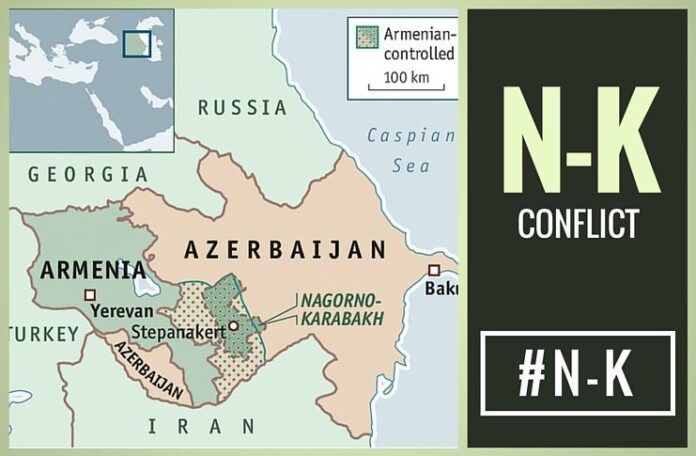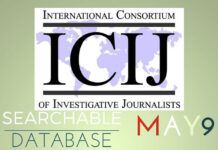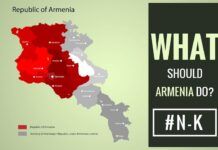
This is Part 2 of the series on the N-K conflict, whose Part 1 is available here.
The two adversaries view the Nagorno-Karabakh (N-K) issue from different perspectives. The Armenian name for Karabakh is Artsakh or Khachen, which was an integral part of Armenia. From a historical perspective, Artsakh was called Urtekhe from 9th to 6th centuries BCE. In 387 AD, Artsakh was part of an eastern Armenian kingdom, when it fell to Persia, and then to Russia during the Russia-Persian war of 1804-13. During the 1918-20 period, Artsakh had all the trappings of an independent state, which explains why Armenia treats N-K as a separate, officially unrecognised state.3 Since the majority of the inhabitants of N-K are Armenians, Azerbaijan regards this policy as an annexation. Armenia has set these conditions for peace:
- N-K inhabitants must have the right of self-determination.
- Armenia must control the land corridor within N-K.
- The security of N-K must be internationally guaranteed.
The long history of subjugation and the fight for emancipation led Armenians, especially the Armenian Revolutionary Federation (ARF), to believe that they had to be aggressive to achieve anything. Patriarch Nerses Varjabedian summarised the experiences of his flock by saying in the 19th century, “The Turks killed the body but the Russians killed the soul.4 As with Ukraine, it was hoped that Armenia and N-K would one day join the EU and NATO. In the meantime, the N-K peace process is handled by the Organization for Security and Cooperation in Europe’s (OSCE’s) Minsk group with Russian cooperation.
Had Patriarch Varjabedian lived today, he would find that Russia is nourishing the Armenian soul. Russia has been supplying arms to Armenia. In September 2013, Armenian President Serzh Sargysian announced that Armenia would join the Customs Union set up by Russia, Belarus and Kazakhstan. Energy distribution in Armenia is financed and controlled by Russian RAO-UES since 2015. Russia assisted in establishing the Yerevan Thermal Power plant. Armenia is a member of the Commonwealth of Independent States.5 Recently, Russia offered Armenia a loan of $200 m to buy arms from Russia.
But the geo-politics of the region have changed to give Azerbaijan military superiority over Armenia. Hydrocarbon in Azerbaijan has given Azerbaijan the ability to improve its military capability and dictate terms. Azerbaijan wants Armenia, as a condition of peace, to withdraw from N-K as required by four UNSC resolutions.6 Even during the Soviet era, since 1923, N-K was treated as part of Azerbaijan. Azerbaijan is not willing to lose 16% of its territory, with a humiliating record of 800,000 displaced citizens. A former President of Armenia Ter-Petrosian recognised the need for Armenia to choose between growth and N-K, meaning that N-K had to negotiate successfully with its neighbours in order to prosper.7
Experienced commentator Galib Mammadov8 catalogues Armenia’s loss of power. In 1993, Turkey closed its border with Armenia as a gesture towards its ethnic neighbour, Azerbaijan. Armenia rejected a Muslim offer of including it in its Baku-Ceyhan pipeline project if it withdrew from N-K. One can understand Armenia’s need to protect N-K, where Armenians are in the majority. But Armenia was deeply aware of the Armenian genocide, whose centenary it had celebrated on April 24, 2015, the loss of the province of Kar to Turkey, and Javack to Georgia, by the Treaty of Kar.9 Armenia also has demographic problems: Armenia has a population of just 3.8 million after 1.1 million left the country as economic migrants. While Armenia’s population is dwindling, Azerbaijan’s is rising.
Notes
- Aynur Karimova, “Global ignorance of N-K conflict should be blamed for renewed hostilities,” azernews.az, April 4, 2016.
- UNSC Resolution 62/243, “The situation in the occupied territories of Azerbaijan.”
- Armenia’s President’s Office, “N-K Republic: History and current reality.” president.arn.
- Simon Vratzian, “The Armenian Revolution and the Armenian Revolutionary Federation,” The Armenian Review, vol.3, No.3, October 1950. The ARF was founded in 1889-90.
- CIA Factbook: N-K, Wikipedia.org.
- Can Kasapoglu, “N-K: Rehearsal for an upcoming war?” aljazeera.com, April 3, 2016.
- Galib Mammadov, “N-K conflict: Armenia’s Victory or Nightmare?” foreignpolicyjournal.com, October 13, 2011.
- Ibid
- Russian Stalin and Turk Ataturk signed the Kars Treaty apportioning these lands.
- Part2 – China’s Road to Superpower status - July 20, 2017
- Part1 – China’s Road to Superpower status - July 18, 2017
- P2 – Can or should Qatar be ostracised? - June 29, 2017










